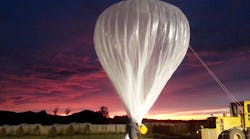In New Zealand, 30 high-altitude balloons are being evaluated for their ability to provide Internet connectivity to an area covering about 10,000 square kilometers. Dubbed “Project Loon,” this Google project uses high-tech balloons that float as high as 20 km in the stratosphere. Using radio antennas, they could enable Internet access at a performance level that is similar to third-generation (3G) networks. Project Loon currently uses the industrial, scientific, and medical (ISM) bands at 2.4 and 5.8 GHz.
Designed in partnership with Raven Aerostar, the “lighter than air” balloons--which are about 60 feet tall--are steered using predictable wind patterns and solar power. By strategically using the wind patterns, the balloons can form groups that act as one large network. The solar panels produce 100 W of power while simultaneously charging a battery for use at night. Made from sheets of polyethylene plastic, the balloons are capable of withstanding higher pressure than typical weather balloons.
Although the project is still in its early stages, Google ultimately hopes to build a ring of balloons around the entire planet, providing Internet access to all.
For a closer look at Project Loon and the balloons they use, watch the video below.
More information can also be found at www.google.com/loon.

